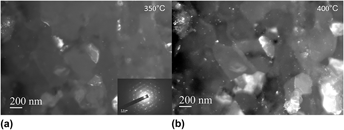Published online by Cambridge University Press: 15 July 2014

In situ transmission electron microscopy (TEM) analysis shows that submicrometer grains formed by ultrasonic impact treatment (UIT) of sensitized 5456-H116 Al–Mg alloy products are thermally stable up to ∼300 °C which is consistent with previous research on annealing of heavily deformed Al–Mg. Grain growth occurs above 300 °C with significant growth at ∼400 °C. Grain growth continued upon heating to 450 °C; the grain size did not significantly increase when the temperature was held at 450 °C long term. In situ TEM revealed a duplex microstructure that was not fully recrystallized. The activation energy for grain growth was determined to be ∼32 kJ/mol. The submicrometer grains produced by UIT offer improved resistance to fatigue and corrosion. The majority of sensitized 5456-H116 failures are sensitive to the material's surface properties and operational service temperature; the stability of the submicrometer grains in the UIT Al–Mg makes them more stable in practical operations where increase in the material temperature is an issue.